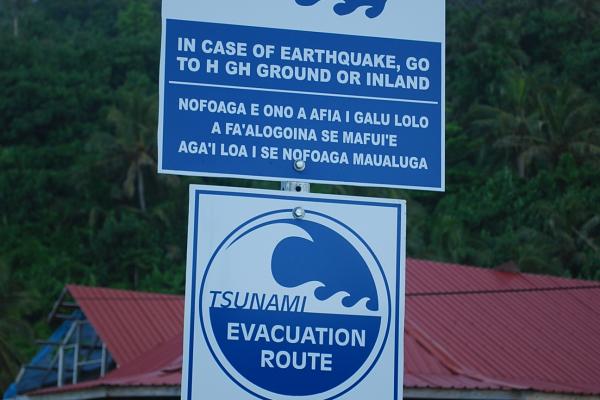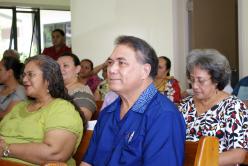From Tsunami to Renewal: A Review of American Samoa's National Emergency Grant Program

Project
In the wake of a devastating tsunami that eliminated one in eight jobs in the territory overnight, American Samoa received the largest National Emergency Grant ever awarded by the US Department of Labor – nearly $25M – to support the recovery process. Within weeks, despite severely compromised infrastructure, the Department of Human Resources (DHR) - the agency charged with planning and implementing the NEG initiative - launched a public jobs program. NEG program staff recruited and employed over 2,361 people in cleanup and recovery efforts at 65 worksites between November 2009 and April 2010. They launched the program without an existing one-stop career center or other key Department of Labor assets common to states on the US mainland and in the context of a village-level community leaders and faith-based organizations with limited prior experience managing employment and recovery efforts on the scale required in the wake of the tsunami.
In 2010, the NEG Program, following the NEG disaster grant requirements issued by the US Department of Labor, shifted it focus to longer term workforce development including training, education, and helping the over two thousand NEG temporary workers and hundreds of unemployed job-seekers affected by the tsunami transition to new jobs or education and training aimed at helping them build careers.
This second phase of the NEG Program emphasized:
- Adopting a broader regional approach to cultivating economic opportunity, reaching out to the neighboring Pacific Islands and US territories.
- Raising the skill levels of low-skilled workers so that they would have better employment opportunities on- and off-island, regardless of their chosen career paths.
- Investing in specfic vocational and technical training programs intended to prepare workers for existing opportunities aligned with their interests or experience.
- Helping workers who had already demonstrated interest in or participation in higher education advance.
In the spring of 2012, the Department of Human Resources of the American Samoa government commissioned Social Policy Research Associates (SPR) to conduct a review of the NEG program. Unlike a formal evaluation, the primary goal of the review was to help the NEG team and partners document their experience and identify lessons and opportunities that might influence the remainder of the NEG program or complementary education, workforce or economic development initiatives in American Samoa.
Methods
We designed an approach that emphasized:
- Interviews. We conducted dozens of interviews with government, business and community leaders, program managers, and project leaders who had experience with the NEG Program in American Samoa and in Guam. Thirty-five of these were video interviews. We also spoke with NEG participants, training providers, and NEG partner agencies about their experiences - what they did, what they learned, and what difference they thought it made. Some of these interviews were conducted in a more ethnographic way - in people's villages, yards, even homes - so that we might learn as much about context as content.
- Data and file reviews. We reviewed spreadsheets, project files, worksite binders, media, and other resources that helped us understand the nature of the program and how it had evolved.
- Story gathering. We engaged a local team, American Samoans who worked with us as 'story gatherers' the entire time we were on-island, collecting stories about the tsunami experience from people who lived through it. We felt this was important context as it is difficult to exaggerate the magnitude and range of challenges that NEG staff were faced with in the storm's aftermath - from the absence of power to the lack of safe shelter for the night.
Findings
We found a workforce development strategy that blended capacity building, bold program investments, and direct business engagement with the aim of connecting people to jobs leading to careers. The NEG program brought new testing and training opportunities to American Samoa's only college. It created a diverse range of work opportunities for hundreds of participants, including a first-of-its-kind culinary academy. It debuted the island's first One-Stop Career Center, and more recently, as part of an effort to advance a regional agenda, initiated programs in construction in Guam and professional services in American Samoa that make talent central to economic development.
While not strictly a part of the strategy, the NEG also did something as important as any of its individual programs or initiatives: it revealed the critical importance of investing in workforce development as a foundation of the territory's future prosperity.
The Executive Summary and Full Report identify both lessons from the program and recommendations for improving economic opportunities for American Samoans in the territory.
Products
The project's deliverables include:
- A thirty-five minute video documentary about the tsunami and NEG project called "From Tsunami to Renewal."
- A report detailing the context, program, lessons, and results to date of the American Samoa National Emergency Grant Program.
- Profiles of three NEG initiatives that demonstrated creative responses to documented need, engaged new partners, and generated excitement among "the public" - people with no direct connection to the NEG program.
- A website and project archive that includes: links and/or downloadable documents or videos cited in the report; "Stories from the Community" - video interviews produced by the story gatherers in which islanders described their experiences during the tsunami; and other relevant documents and resources.
Project Team
Our primary research team comprised 13 people:
- An SPR team of five (Vinz Koller, Kristin Wolff, Dae Woo Son, Elizabeth Waiters, and Aleixo Gonçalves) spent between 2 and 5 weeks in American Samoa and Guam conducting interviews, file reviews, and gathering video, and working with our Samoan colleagues to understand the NEG program in its entirety.
- A logistics and support team of four (James Faumuina, Fa'aolataga Finou Fusitu'a, Lupi Leasoon, and Noai Silao) helped us navigate government and community based agencies and organizations, private-sector firms, and the villages, and then transcribed translated, and otherwise assisted with data processing. Without their help, there would be no report; without their openness, there would be far less to share.
- A story gathering team of four (Jacqueline Leatigaga, Brett Levu, Spencer Toeava, and Iosefa Siatini) who shared their stories with us, collected stories of their neighbors, colleagues, and friends (using flipcams), and became integral members of the research team within a day of our arrival on island and remained so all the way through the project.
We also want to recognize the following individuals at Social Policy Research who provided logistics support, assistance with document or video production, and communications support throughout the project: Laura Aron, Trace Elms, Sam McCoy, and Miloney Thakrar.
Finally, central to our ability to complete the project was Evelyn Vaitautolu-Langford and her team at the Department of Human Resource – Makerita Enesi, Toti Fata, Tauapa'i Laupola, Patrick Reid, and Silia Time – and Professors Failautusi Avegalio and C.L. Cheshire. All of them helped us understand the program by sharing information and data, explaining evolving strategies, and identifying what they had learned.
Website
If you are reading this, you have found your way to the Project tab, which offers an overall description of the project and an orientation to the resources on this website.
The Recovery tab provides a summary of phase I of the NEG Program: the temporary jobs phase.
The Renewal tab offers a brief descrption of phase II of the NEG Program - the workforce development phase - and offers three profiles we crafted in order to illustrate the program in a more three-dimensional way. Each is accompanied by a corresponding video. Finally, we provide a summary of activities that occured after our initial review was complete (the program is ongoing through June 2013) and promise additional results and, perhaps more importantly, impact over time.
The Media tab provides access to all project videos: the thirty-five minute documentary, the behind-the-scenes and story gatherer vidoes, and others, together with appropriate guidance for the viewer. We encourage viewers to share these videos with others who may be interested.
The Library tab servces as the project's bibliography, and contains links to reports, analysis, articles, and other resources we used to inform the project. Most of these resources are accessible directly through the link, but some require downloading.
The Stakeholder tab povides descriptions of and links to NEG project partners and other organizations and agencies who have a compelling interest in American Samoa's economic future and the kinds of work, learning, and business opportunities the territory offers its residents.
Finally, the Report tab offers access to the Executive Summary, Full Report, and Project Profiles, which comprise the bulk of our analysis.
Thank you for your interest.
- The NEG Project Team


